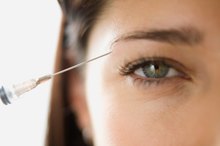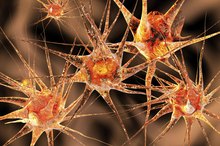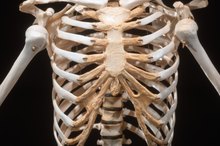What does fact checked mean?
At Healthfully, we strive to deliver objective content that is accurate and up-to-date. Our team periodically reviews articles in order to ensure content quality. The sources cited below consist of evidence from peer-reviewed journals, prominent medical organizations, academic associations, and government data.
The information contained on this site is for informational purposes only, and should not be used as a substitute for the advice of a professional health care provider. Please check with the appropriate physician regarding health questions and concerns. Although we strive to deliver accurate and up-to-date information, no guarantee to that effect is made.
Nutrition of Bone vs. Nutrition of Cartilage
Your bones are made of minerals such as calcium, magnesium and phosphorus. Your bones also contain collagen, which provides the matrix, or structure, onto which minerals are deposited. Cartilage is made from proteins, sugars and collagen. Bones and cartilage need some of the same nutrients. Your bones and cartilage both need protein, but bones also need a number of other nutrients to be healthy 1. They obtain nourishment in different ways.
If you are experiencing serious medical symptoms, seek emergency treatment immediately.
Your Bones
Bones and cartilage both provide structure to the body; cartilage may provide structure to non-weight bearing areas, such as the nose, or act as a shock absorber between bones in places like the spine or knees. Bones help to protect body organs such as your brain, lungs and heart. They also provide an anchor point for muscles. Bones are the calcium storehouse for the body – if you need more calcium in your bloodstream, your body will strip calcium from the bones.
- Bones and cartilage both provide structure to the body; cartilage may provide structure to non-weight bearing areas, such as the nose, or act as a shock absorber between bones in places like the spine or knees.
- Bones help to protect body organs such as your brain, lungs and heart.
Bone Nutrients
Types of Gliding Joints
Learn More
Calcium and phosphorus are the two nutrients that are most important for bones; between 80 and 90 percent of your bone structure is composed of calcium and phosphorus. Calcium is the most abundant mineral in the body and is critical for bone formation; your body cannot make this mineral, so you must obtain it through food sources such as dairy products, dark green leafy vegetables and almonds.
Nutrient Sources
Bones get nutrients from the bloodstream, while cartilage is nourished by the synovial fluid that surrounds your joints. Synovial fluid contains the proteins and sugars necessary for cartilage nutrition and also removes waste products excreted by cartilage. These processes occur through passive diffusion, which means the nutrients and waste products move back and forth across cell membranes, and are supported by physical activity that includes joint movement. Bones are nourished from substances extracted from the bloodstream, and physical activity is not necessary to transport nutrients or waste products.
- Bones get nutrients from the bloodstream, while cartilage is nourished by the synovial fluid that surrounds your joints.
- Bones are nourished from substances extracted from the bloodstream, and physical activity is not necessary to transport nutrients or waste products.
Protein and Silicon
Ear Cartilage Infection Symptoms
Learn More
Protein is a nutrient required by both bones and cartilage. Protein contains amino acids – often called the building blocks of protein – that are broken down in the body and then used to assemble organ, bone and cartilage cells. Protein also provides iron, zinc, vitamins and other nutrients the bones need. Silicon is another nutrient needed by both bones and cartilage; silicon stimulates the development of collagen, which is present in both bones and cartilage.
- Protein is a nutrient required by both bones and cartilage.
- Silicon is another nutrient needed by both bones and cartilage; silicon stimulates the development of collagen, which is present in both bones and cartilage.
Related Articles
References
- RaySahelian.com: Cartilage Supplement, Vitamins, Herbs, Natural Ways to Improve and to Have Healthy Tissue
- Orthobullets. Articular cartilage. Updated January 9, 2020
- Centers for Disease Control and Prevention. Osteoarthritis (OA). Reviewed February 27, 2020
- Li G, Yin J, Gao J, et al. Subchondral bone in osteoarthritis: insight into risk factors and microstructural changes. Arthritis Res Ther. 2013;15(6):223. doi:10.1186/ar4405
- American Academy of Orthopaedic Surgeons. Arthritis of the knee. Reviewed June 2014.
- Junker S, Krumbholz G, Frommer KW, et al. Differentiation of osteophyte types in osteoarthritis - proposal of a histological classification. Joint Bone Spine. 2016;83(1):63-7. doi:10.1016/j.jbspin.2015.04.008
- American Academy of Orthopaedic Surgeon. Articular cartilage restoration. Reviewed February 2009
- Brown C, Mckee C, Bakshi S, et al. Mesenchymal stem cells: Cell therapy and regeneration potential. J Tissue Eng Regen Med. 2019;13(9):1738-1755. doi:10.1002/term.2914
- American College of Rheumatology. Osteoarthritis. Updated March 2019
- Articular Cartilage. Joint Replacement Institute.
- Articular Cartilage Restoration. American Academy of Orthopaedic Surgeons.
- What Is Cartilage? International Cartilage Repair Society.
Writer Bio
Beth Greenwood is an RN and has been a writer since 2010. She specializes in medical and health topics, as well as career articles about health care professions. Greenwood holds an Associate of Science in nursing from Shasta College.









